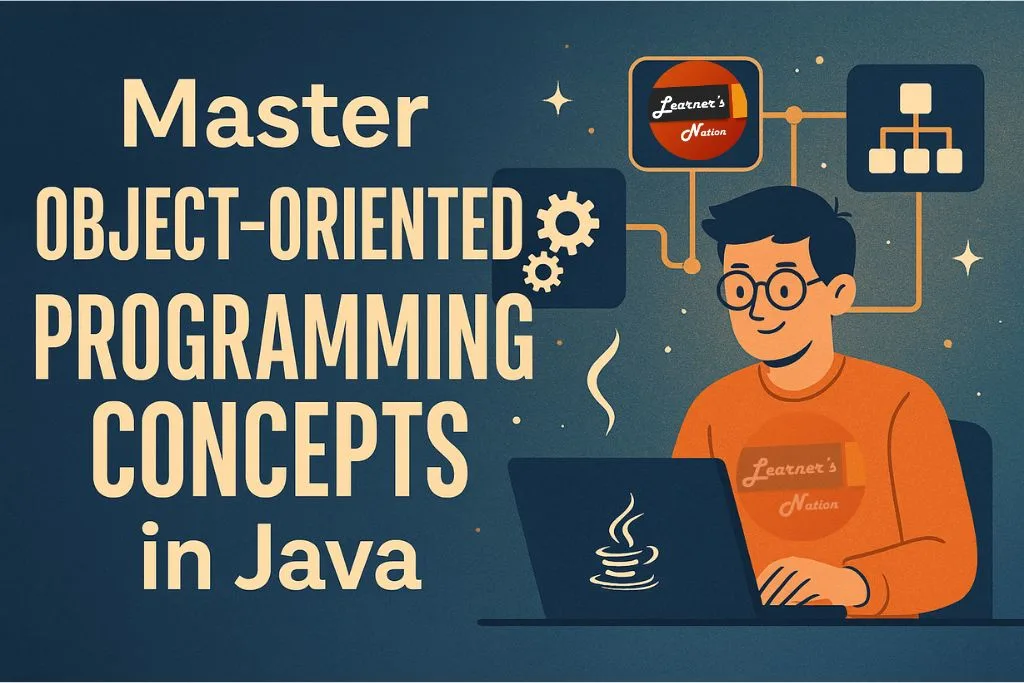Ultimate Guide: Master Object Oriented Programming Concepts in Java with Examples for Beginners
Are you struggling to understand Java’s object-oriented approach? Whether you’re a student, beginner programmer, or preparing for interviews, learning object oriented programming concepts in Java with examples for beginners is essential to your growth as a Java developer.
In this in-depth blog, you’ll explore:
- The core pillars of OOP in Java
- Real-world examples and Java code
- Benefits of OOP in practical projects
- How to apply these concepts confidently
By the end of this article, you’ll not only understand but also be able to implement object oriented programming concepts in Java with examples for beginners in your own applications.
What is Object Oriented Programming (OOP) in Java?
Object-Oriented Programming (OOP) is a programming paradigm based on the concept of “objects” which contain data and code. Java is a fully object-oriented language that promotes clean, modular, and reusable code.
The four main object oriented programming concepts in Java with examples for beginners are:
- Encapsulation
- Inheritance
- Polymorphism
- Abstraction

Understanding Class and Object: Foundation of OOP
Before you learn the core OOP concepts, you must understand what classes and objects are.
Class
A class is like a blueprint for creating objects. It defines properties (variables) and behaviors (methods).
Object
An object is an instance of a class. It has state and behavior.
//Class & Object
class Mobile {
String brand;
int price;
void call() {
System.out.println("Calling...");
}
}
public class Main {
public static void main(String[] args) {
Mobile m1 = new Mobile();
m1.brand = "Samsung";
m1.price = 15000;
m1.call();
}
}
This is the first step to mastering object oriented programming concepts in Java with examples for beginners.
Encapsulation in Java
Encapsulation is the process of hiding data within a class and allowing access through public methods. It keeps the internal state of an object protected from outside interference.
Real-life Analogy
Think of a coffee machine: you press a button, and coffee comes out. You don’t need to know how it works inside — that’s encapsulation.
class Student {
private String name;
public void setName(String name) {
this.name = name;
}
public String getName() {
return name;
}
}
public class Main {
public static void main(String[] args) {
Student s = new Student();
s.setName("Rahul");
System.out.println(s.getName());
}
}
Encapsulation keeps code modular, improves maintainability, ensures data protection. Using encapsulation is one of the fundamental object oriented programming concepts in java with examples for beginners.
Inheritance in Java
Inheritance allows a new class (child) to reuse the fields and methods of an existing class (parent). This promotes code reusability and hierarchical classification.
Real-life Analogy
A child inherits traits from parents. Similarly, a subclass inherits features of a superclass.
class Animal {
void eat() {
System.out.println("Eating...");
}
}
class Dog extends Animal {
void bark() {
System.out.println("Barking...");
}
}
public class Main {
public static void main(String[] args) {
Dog d = new Dog();
d.eat();
d.bark();
}
}
Inheritance reduces redundancy, easier to extend functionality, improves readability. This is a critical piece of object oriented programming concepts in Java with examples for beginners that’s commonly asked in interviews.
Polymorphism in Java
Polymorphism means “many forms”. A method can perform differently based on the object calling it.
Java supports two types:
- Method Overloading (Compile-Time Polymorphism)
- Method Overriding (Runtime Polymorphism)
//Method Overloading Example
class Calculator {
int add(int a, int b) {
return a + b;
}
double add(double a, double b) {
return a + b;
}
}
//Method Overriding Example
class Parent {
void display() {
System.out.println("Parent display");
}
}
class Child extends Parent {
void display() {
System.out.println("Child display");
}
}
Polymorphism Enables dynamic behavior, simplifies code, essential for abstraction and interfaces.
Abstraction in Java
Abstraction means hiding complex implementation details and showing only the essential features.
Two Ways to Achieve Abstraction:
- Abstract Classes
- Interfaces
//Abstract Class Example
abstract class Shape {
abstract void draw();
}
class Circle extends Shape {
void draw() {
System.out.println("Drawing circle");
}
}
//Interface Example
interface Drawable {
void draw();
}
class Rectangle implements Drawable {
public void draw() {
System.out.println("Drawing rectangle");
}
}
Abstraction promotes modular code, decouples logic, supports interface-based design. This is must-have in your toolkit when applying object oriented programming concepts in Java with examples for beginners.
Constructor
A constructor initializes an object.
class Book {
String title;
Book(String t) {
title = t;
}
}
this Keyword
Used to refer to the current object.
class Car {
String model;
Car(String model) {
this.model = model;
}
}
Real-World Applications of OOP in Java
- Android Development – Java-based apps use OOP for modular code
- Banking Systems – Secure encapsulated user data
- E-commerce Platforms – Product and order classes with inheritance
- Games – Characters and behaviors modeled as objects
Advantages of OOP in Java
- Reusability
- Security
- Flexibility
- Cleaner code
- Easy testing and debugging
OOP is not just a concept, it’s a philosophy for writing efficient, manageable, and scalable code — and learning object oriented programming concepts in Java with examples for beginners is your gateway to it.
Frequently Asked Questions
Q1: What are the 4 basic principles of OOP in Java?
A: Encapsulation, Inheritance, Polymorphism, and Abstraction.
Q2: Can Java support multiple inheritance?
A: Java supports multiple inheritance using interfaces, not classes.
Q3: Is Java 100% Object-Oriented?
A: Not fully — primitive types like int, char are not objects.
External Resources
Mastering object oriented programming concepts in Java with examples for beginners sets the stage for long-term success in your programming career. You now understand how to:
- Use encapsulation for secure code
- Apply inheritance for reusability
- Leverage polymorphism for flexibility
- Implement abstraction for simplified logic
Keep practicing! The more you apply these concepts in real projects, the more confident you’ll become.


